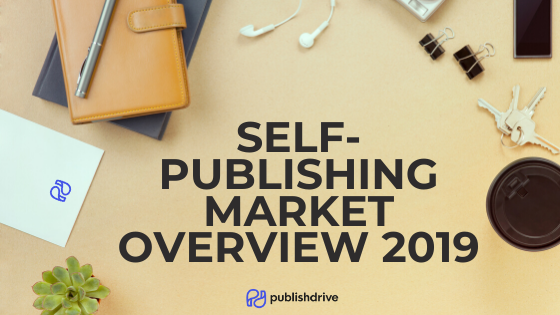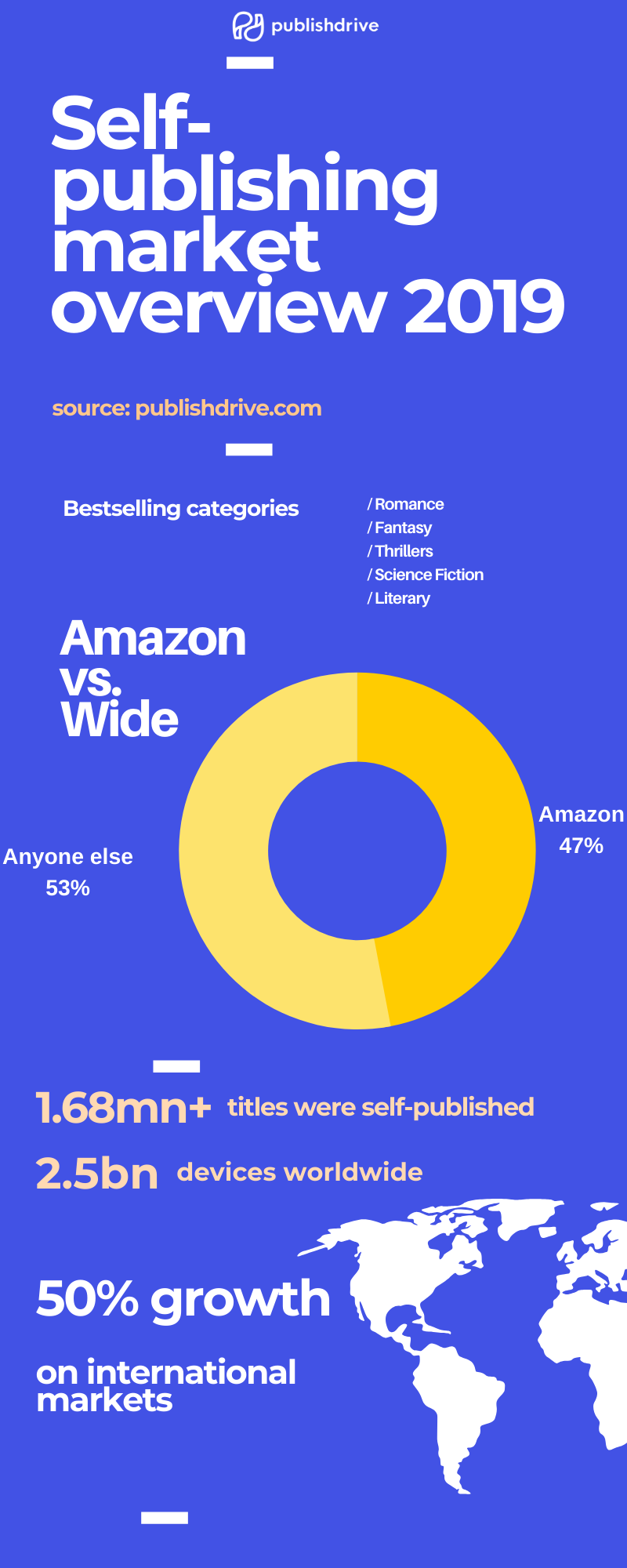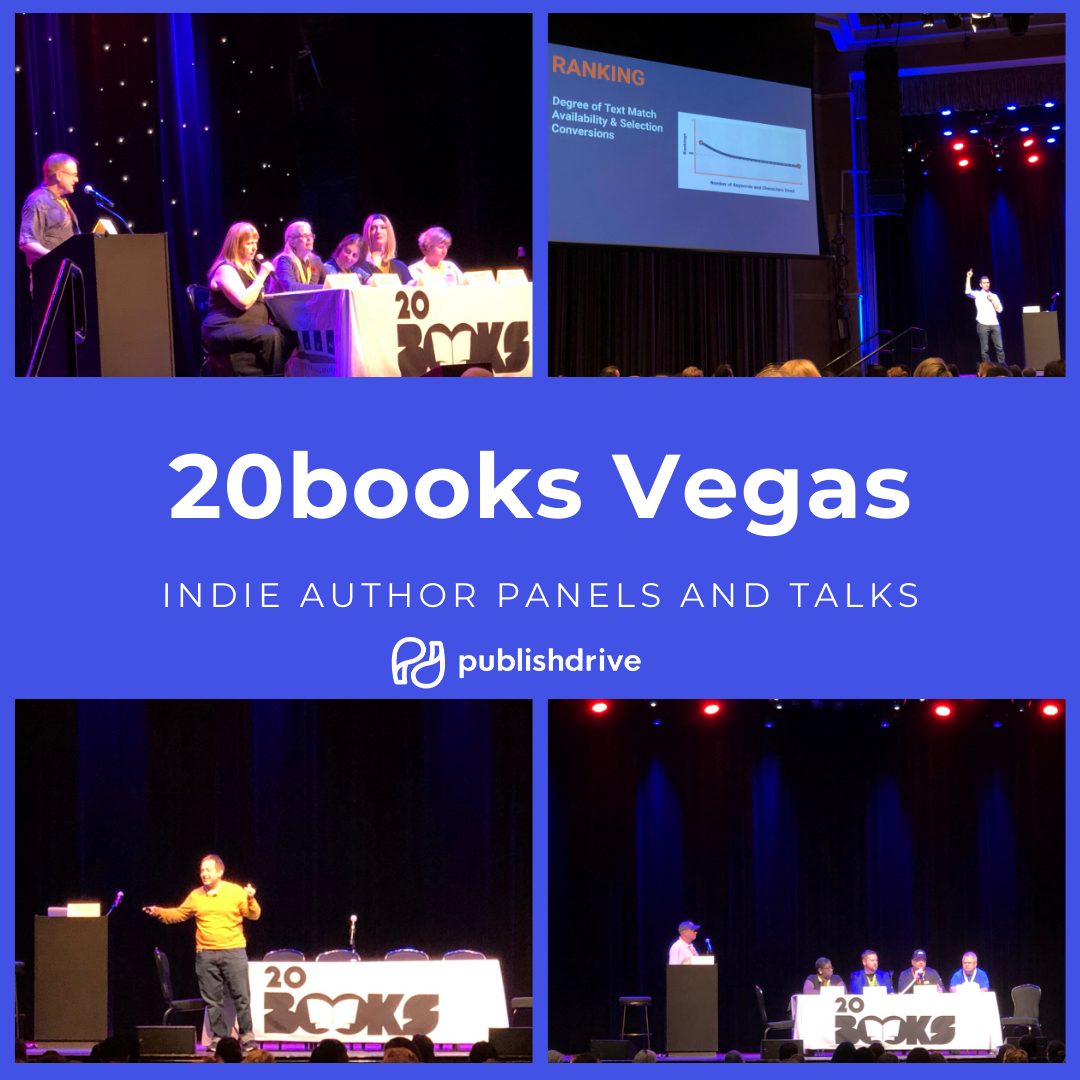Self-Publishing Market Review 2019

The self-publishing market in 2019 showed that there has never been a better time to become a writer. If you are interested in getting to know more about the most significant milestones in the industry and where it is heading, you are in the right place. This blog post is about showcasing what happened in 2019 that will shape our journey in the next coming years.
1. What is self-publishing?
"Self-publishing is the publication of media by its author without the involvement of an established publisher" - according to Wikipedia. Self-publishing means that the author manages the book. In this case, the control stays with the author throughout the whole process from design, editing, production, price, marketing, distribution, and also, accounting.
As the term 'self-publishing' states, the author may perform the different publishing activities themselves, but they also may outsource these tasks by forming a team.
What this means for you as an author: There has never been a better time to be a writer. You can publish your story on multiple platforms, and you do not need a publishing company to do that if you do not want to.
2. The self-publishing market growth
The self-publishing market grew rapidly: 1.68m books were self-published in 2018. As authors can create print, ebooks, and audiobooks with better tech support, the number of titles will be growing even faster in the future. Still, more than 40% of the overall ebook sales came from self-published authors in 2018.
The most popular genres in self-publishing are romance, followed by mystery/thriller/crime. In the last few years, emerging markets like India or China were included in the global self-publishing book market where non-fiction titles are trending.
What this means for you as an author: If you were thinking of getting traditionally published, there is no need to do that. Readers already love self-published titles in different formats, and you are not alone! You have thousands of reliable resources to learn about the process.

3. US retailers re-invested in the market
Kindle Direct Publishing (KDP) is Amazon's self-publishing platform that started in 2012. This year new features were introduced like a one-year lead time on pre-order publishing. They also made their advertising platform available in more markets like the UK and Germany.
When you google 'where to buy an ebook,' you can find other reading platforms as well. Just to mention a few: Apple Books, Scribd, Kobo, Barnes & Noble, or Google Play Books are among the most popular ones. 2019 was the resurrection of 'Going Wide' meaning that publishing outside of the Amazon world got more popular. As a result, many stores reinvested in their publishing efforts or received significant funding to do so
- Apple released a new reader experience in 2019 with features like wishlist titles to read. Apple is known for its solid user experience in all products, so books could not be an exception either. Besides the beautiful book pages where you can download sample chapters, you can mark the book ‘Reading now’, so it is easier to find your books you’re currently reading or listening to. I love this strategic move of Apple - as they focus on readers first! :)
- Barnes & Noble introduced a new advertising platform following the success of Amazon Advertising.
- Kobo jumped on the bandwagon of audiobooks introducing this format in their platform. Also, they are stepping foot in the subscription business in Belgium and the Netherlands.
- Google Play Books started to reshape its business model similar to Amazon Kindle by introducing a 70% payout in some of the territories. Also, they restructured how they work with ebook aggregators - so most of them decided not to work with Google Books anymore. PublishDrive is the only ebook aggregator helping with publishing on Google Play Books.
- Scribd faced a robust international growth in 2018 and they closed a $58m funding to support growth and product innovation, enhance operations, and further the company's mission to change the way the world reads. Scribd has over 1million paying readers worldwide.
What this means for you as an author: You have multiple options to distribute your books. Retailers are getting more serious about competing with Amazon and providing the best reader experience. Reinvestment in the market means happier readers and happier authors!
4. The quality of self-published books increases
Traditional publishing was only accessible for a few who were able to get through the gatekeepers. With innovation in self-publishing, publishing got democratized.
a. Indie authors are getting recognized by the industry
The expression 'Indie publishing' gained attention in the industry, meaning: rewrite the rules of publishing to ensure, writing is a business, not just an art.
It turns out that self-publishers know even better how to bond with readers, and get them what they want. This year, on a panel at San Francisco Writers Conference, a literary agent just told the hard truth: 'whether you are self-published or on the traditional route, you will need to put the same effort into author branding and to build your audience.'
It might be the reason why the industry recognized so many indie authors. Without mentioning all, Susannah Nix or Elizabeth Dyer won RITA award, nominations from Bram Stoker Award to Angela Yuriko Smith and Howard David Ingham, nominations from Nebula/HUGO award to A.K. DuBoff, Yudhanjaya Wijeratne and R.R. Virdi, Rhett C. Bruno and Richard Fox.
b. Self-publishing influencers develop their business
2019 was a successful year for many influencers who help other authors grow. Major publications covered the business growth of Dave Chesson, Kindlepreneur, and Chandler Bolt with Self-Publishing School in the US.
Also, UK authors had a great year. Joanna Penn, who shares everything about self-publishing with the Creative Penn, started to venture out in a new podcast. Her new podcast is about Books and Travel focusing on indie authors.
Mark Dawson's new book's advanced reader copy launch was blowing me away when I saw it first on Instagram. This is the true indie author spirit! :)
c. New quality standards are introduced
The standards of self-publishing are getting closer to the traditional world. Part of the quality requirements come from retailers like Amazon, but also self-publishing companies like PublishDrive, but most importantly, from readers' expectations.
Scamming is a serious attempt that most of the stores do not tolerate: repackaging public domain books, or private label rights books with no exclusive copyright ownership is not allowed in stores.
What this means for you as an author: if your main goal is to build a sustainable business with self-publishing and distribution, you need to provide unique content to readers. Thus, the recent developments in 2019 are in your favor.
5. Market growth in self-publishing
Where does the growth on the market come from? From new formats, better marketing tools and the support from the indie author community.
a. Self-publishers enter new formats
Ebooks are the majority of the income of an indie published author, but print books and audiobooks are your best bet for future growth.
With the recent developments at Amazon KDP Print On Demand, you have a more accessible option to sell books for publishing companies.
Apple Books and Kobo also started to open up its audiobook platform. Findaway Voices not just improved the Author Direct to sell audiobooks directly to listeners, but also engaged in a partnership with Bookbub Chirp to offer recommendations for audiobooks to surf on the waves of the industry.
b. Better marketing tools for indies
Marketing and promotions are still a significant pain point of indie authors. That’s why more companies invested in this area in 2019.
- Cover Design: they say, don’t judge a book by its cover, but everyone still does that. Thankfully, with DIY tools like Bookbrush, you can create beautiful images. Also, there are plenty of freelancers or companies you can hire for a professional cover design.
- Author Pages: when it comes to online marketing, you should never forget about SEO (search engine optimization) and building your author brand. You can have an Amazon Author Page through Amazon Author Central Pages. Just open an Author Central Account and link your books to your Amazon Author Page. Also, do not forget to publish on Google Play Books to take advantage of being listed on the world’s biggest search engine platform!
- Amazon Advertising is the most powerful tool for your titles on Amazon. They introduced Product Targeting options that allow you to target any product on Amazon or similar titles in your category. The latter is done automatically with PublishDrive’s built-in Amazon Advertising tool.
- Written Word Media is another excellent platform for book promotions. I just love their new design! They have different brands based on your book category or price to make your books more visible for the right readers and boost book sales.
- Promotions with stores are getting more critical than ever as you have more books to stand out from. Check out all the options you can get wide.
c. Community growth and support
Writing is lonely, but publishing should not be. Authors and writers get together to talk about business at 20books Vegas for the third time in 2019. Make sure; you are part of the 20booksto50k FB group to get the most knowledge on how to build your author empire.

What this means for you as an author: Your marketing options and the tools you can use are a big ocean - you can spend a tremendous amount of dollars on advertising, but you do not have to. There are other smart ways you can market your books today, and the limits are the sky when it comes to creativity!
6. Trends in self-publishing
a. International growth
The international markets started to grow in 2019 rapidly. Amazon KDP Print expanded its services to more markets like Canada, but also pulled out from some global markets, like China.
We could see a 50% growth in international markets for English language titles in 2019. As a result, many retailers opened new local stores or promotional opportunities, like in the case of Scribd for Spanish and Romanian titles. You can read other information about international growth in PublishDrive's review of 2019.
b. Collaboration
Fiction writers face a new trend with co-publishing and collaboration, which allows authors to use IPs more effectively and create more content faster. Yudhanjaya Wijeratne branded collaboration as The Future of Publishing at 20books Vegas, and many indies grew their author empire with the help of cowriting. Read more about the different forms of cowriting, coauthoring, anthologies, and also, the 10 tips to become a coauthor. Michael Anderle from LMBPN also shared their boost in productivity with using collaboration tools like Abacus.
c. A mix of publishing strategies
I've started to see more conscious indies in 2019 who leverage the power of different platforms. More indie authors are aware of the benefits of going wide and what they should expect compared to the Kindle Unlimited strategy.
What this means for you as an author: you need to do things differently than everyone else. Look at international opportunities, collaborate with other authors in book projects, and also, do not keep your eggs in one basket. Diversify your portfolio of books and strategies, so whenever the market shifts, you will be ready to hop on the next wave in the industry!